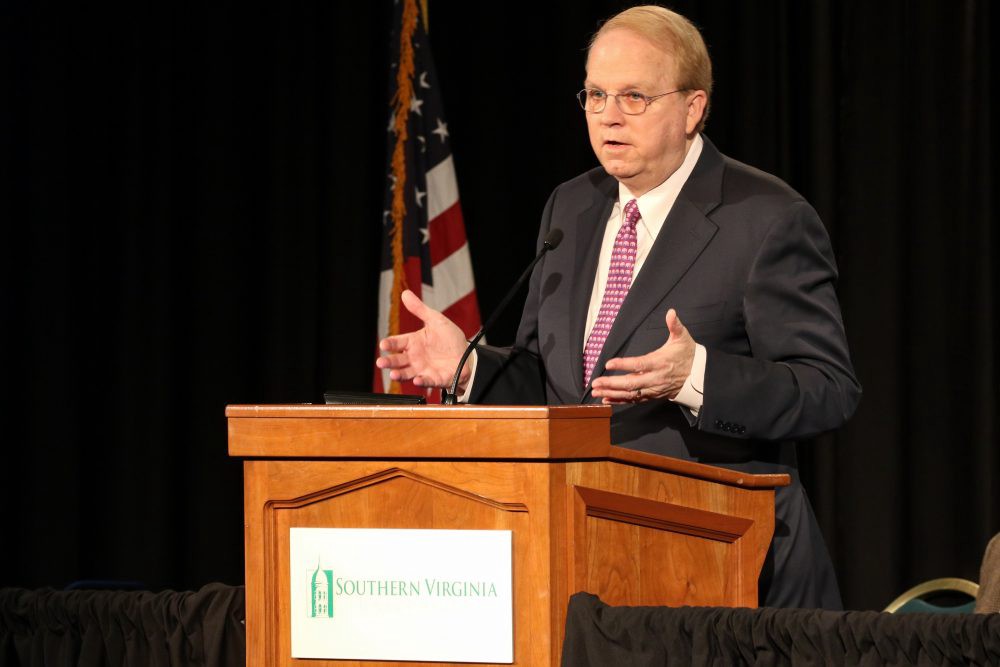News Release
Southern Virginia University Adds Concentrations to Curriculum

At a Friday forum with gathered students, faculty and staff, President Reed N. Wilcox, Interim Provost Scott Dransfield, Associate Provost Dr. Jeremiah John, and Director of Student Professional Development Cameron Crowther, announced the addition of nine new concentrations to the Southern Virginia University curriculum, with the goal of adding 50 concentrations by Fall 2017.
A concentration is an area of study that combines a small number of required courses, with focused advising, directed toward a career or graduate training. Each concentration typically includes a required practical experience, such as an internship, and may also involve a certification. The goal behind the concentrations, according to President Wilcox, is to help students bridge the gap between education and life after college.
“This is a breakthrough,” President Wilcox said. “This idea of concentrations is the future. This is the way we can connect our academic experience here with the next stage — whether it’s graduate school, professional school, a career, whatever it is — this is a connection point.”
According to Provost Dransfield, concentrations are aligned with Southern Virginia’s tradition of personalized education. The chance for faculty to work closely together with students has always been a part of the university’s identity, explained Dransfield.
“As we approach concentrations, I would like to really underscore that we are just refining something that we are already doing,” Dransfield explained. “That is working closely with students, finding out their interests, and channeling them.”

Associate Provost Jeremiah John explained how concentrations complement the university’s existing curriculum to connect students with future success. According to John, Southern Virginia’s core curriculum is designed to give students a breath of knowledge in different areas while individual majors provide students with depth of knowledge in an academic discipline. Concentrations, on the other hand, work in conjunction with the core and majors to help students transfer the skills they have acquired during their education to the next phase of life.
“Concentrations are that final connection that grounds you to whatever you are going to do next,” said John. “The fact that it’s small is by design — we don’t want this to be an entire new major. We don’t want this to be like double majoring.
“In fact, the courses might overlap with a major that you are already doing,” John continued. “If [a concentration] doesn’t overlap with a major you are already doing, then that’s okay because it’s actually going to be pretty modest and small. So this should not add another semester, let alone another year, to your college education.”
Director of Student Professional Development Cameron Crowther concluded the program by explaining that concentrations are only possible at Southern Virginia because of the dedication and devotion of the faculty and professional staff to the success of each individual student.
“This concentrations program would be impossible other places.” Crowther stated, “It is the additional time and energy put into your education — an experience that not everyone gets to have — that makes this possible.”
According to Crowther, concentrations give students the option to design their educational experience, with the help of faculty, to fit their passions. Concentrations, explained Crowther, have been happening informally at Southern Virginia for some time.
Crowther provided several examples of past students who tailored their education at Southern Virginia to help them achieve their professional goals:

With assistance from experienced faculty members, alumnus Bryce Pendleton (’10) was able to build his own concentration in architecture by taking relevant math and physics courses in addition to his major-specific classes in art and politics. He also participated in a study abroad program focused on architectural studies. Pendleton’s informal concentration ultimately led to a master’s of architecture from Virginia Tech’s School of Architecture and Design.
As a family and child development major and art minor, alumna Brynn Willis (’07) also pursued her passion for digital photography. Since graduating, Willis has built a thriving photography career, while raising three children, and pursing a master’s of photography with a focus on documentary-style photography from Savannah College of Art and Design.
Former student body president and alumnus, J.D. Drasbek (’16), studied philosophy while cultivating an interest in healthcare administration. With advice from local health professionals and the university’s student professional services team, Drasbek was able to create a concentration that helped him earn acceptance to the nation’s top healthcare administration program at Virginia Commonwealth University.
“Students who graduate from here, find value in concentrations, in their professional pursuits, and in academics,” Crowther concluded. “Concentrations are about adding a professional component that helps distinguish you from others. It teaches you the hard skills to complement the research and writing skills that are so imbedded in what we do here.”
 News
News